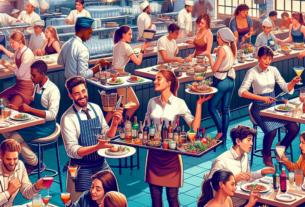Introduction
The restaurant industry is a highly competitive and fast-paced environment. With the rise of digital marketing and the increasing use of technology in the foodservice sector, restaurant owners need to stay ahead of the curve to drive more sales. In this report, we will explore effective restaurant marketing strategies that can help restaurant owners increase their sales and stay competitive in the market.
Current State of the Foodservice Industry
According to a report by CulinaryCoverage.com, the foodservice industry is projected to grow at a steady pace in 2025. With the increasing demand for convenience and the rise of online ordering platforms, restaurants are facing new challenges and opportunities.
Market Share and Volumes
In 2025, the foodservice industry is expected to reach a market size of $1.2 trillion, with a projected growth rate of 4% annually. The market share is dominated by fast-food chains, followed by casual dining restaurants and fine dining establishments.
Financials
The restaurant industry is a profitable sector, with an average profit margin of 6-9%. However, with increasing competition and rising costs, restaurant owners need to be strategic in their marketing efforts to drive more sales and increase their profitability.
Effective Restaurant Marketing Strategies
To drive more sales and stay competitive in the market, restaurant owners need to implement effective marketing strategies that resonate with their target audience and differentiate their brand from competitors. Here are some key strategies to consider:
1. Social Media Marketing
Social media platforms like Facebook, Instagram, and Twitter have become essential marketing tools for restaurants. By creating engaging content, running targeted ads, and interacting with customers online, restaurant owners can increase brand awareness and drive more sales.
For example, a restaurant can showcase its menu items, promotions, and events on social media to attract new customers and keep existing ones engaged. By posting mouth-watering photos and videos, responding to customer reviews, and offering exclusive discounts to followers, restaurants can build a loyal fan base and drive more sales.
2. Email Marketing
Email marketing is a cost-effective way to reach customers directly and promote special offers, events, and new menu items. By building an email list and sending regular updates to subscribers, restaurants can drive traffic to their website, increase reservations, and boost sales.
For instance, a restaurant can send out weekly newsletters with mouth-watering photos, exclusive discounts, and upcoming events to entice customers to visit. By personalizing emails based on customer preferences and behavior, restaurants can increase open rates, click-through rates, and conversions.
3. Online Ordering and Delivery
With the rise of online ordering platforms like UberEats, Grubhub, and DoorDash, restaurants can reach a wider audience and drive more sales. By offering convenient delivery options, easy-to-use ordering systems, and quick turnaround times, restaurants can attract busy customers who prefer to dine at home.
For example, a restaurant can partner with multiple delivery services to expand its reach and streamline the ordering process. By optimizing menu items for delivery, ensuring food quality and presentation, and providing excellent customer service, restaurants can build a loyal customer base and drive repeat business.
4. Loyalty Programs and Rewards
Loyalty programs are a powerful way to incentivize customers to return to a restaurant and drive more sales. By offering rewards, discounts, and exclusive perks to loyal customers, restaurants can increase customer retention, boost average check size, and generate repeat business.
For instance, a restaurant can create a points-based loyalty program where customers earn points for every purchase and redeem them for discounts or freebies. By promoting the program through social media, email marketing, and in-store signage, restaurants can encourage customers to join and engage with the brand regularly.
Future Plans and Innovations
Looking ahead, the future of restaurant marketing will be driven by technology, personalization, and sustainability. With the rise of artificial intelligence, virtual reality, and data analytics, restaurants can create personalized experiences, optimize operations, and reduce waste.
Personalized Marketing
In the future, restaurants will leverage data analytics and artificial intelligence to create personalized marketing campaigns that resonate with individual customers. By analyzing customer preferences, behavior, and feedback, restaurants can tailor promotions, menu items, and messaging to drive more sales and enhance the customer experience.
For example, a restaurant can use machine learning algorithms to predict customer preferences and recommend menu items based on past orders. By sending personalized offers and discounts to customers through email, text messages, and social media, restaurants can increase engagement, loyalty, and sales.
Virtual Reality Dining
Virtual reality technology will revolutionize the dining experience by allowing customers to preview menu items, explore restaurant interiors, and interact with chefs in a virtual environment. By offering virtual tours, interactive menus, and immersive dining experiences, restaurants can attract tech-savvy customers and drive more sales.
For instance, a restaurant can create a virtual reality app that allows customers to explore the menu, watch cooking demonstrations, and interact with staff before visiting in person. By providing a unique and engaging experience, restaurants can differentiate themselves from competitors and attract a new generation of diners.
Sustainable Practices
With increasing awareness of environmental issues and consumer preferences for sustainable products, restaurants will need to adopt eco-friendly practices and reduce their carbon footprint. By sourcing local ingredients, reducing food waste, and implementing energy-efficient technologies, restaurants can appeal to environmentally conscious customers and drive more sales.
For example, a restaurant can partner with local farmers and suppliers to source fresh, organic ingredients and promote sustainable farming practices. By offering plant-based menu options, composting food waste, and using eco-friendly packaging, restaurants can attract eco-conscious customers and differentiate their brand in the market.
Conclusion
In conclusion, restaurant owners need to be proactive in their marketing efforts to drive more sales and stay competitive in the market. By leveraging social media, email marketing, online ordering, loyalty programs, and innovative technologies, restaurants can attract new customers, retain existing ones, and increase profitability. Looking ahead, the future of restaurant marketing will be shaped by technology, personalization, and sustainability, offering new opportunities for growth and innovation in the foodservice industry.



